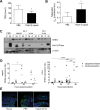Oral Administration of Astrovirus Capsid Protein Is Sufficient To Induce Acute Diarrhea In Vivo
- PMID: 27803180
- PMCID: PMC5090040
- DOI: 10.1128/mBio.01494-16
Oral Administration of Astrovirus Capsid Protein Is Sufficient To Induce Acute Diarrhea In Vivo
Abstract
The disease mechanisms associated with the onset of astrovirus diarrhea are unknown. Unlike other enteric virus infections, astrovirus infection is not associated with an inflammatory response or cellular damage. In vitro studies in differentiated Caco-2 cells demonstrated that human astrovirus serotype 1 (HAstV-1) capsid protein alone disrupts the actin cytoskeleton and tight junction complex, leading to increased epithelial barrier permeability. In this study, we show that oral administration of purified recombinant turkey astrovirus 2 (TAstV-2) capsid protein results in acute diarrhea in a dose- and time-dependent manner in turkey poults. Similarly to that induced by infectious virus, TAstV-2 capsid-induced diarrhea was independent of inflammation or histological changes but was associated with increased intestinal barrier permeability, as well as redistribution of sodium hydrogen exchanger 3 (NHE3) from the membrane to the cytoplasm of the intestinal epithelium. Unlike other viral enterotoxins that have been identified, astrovirus capsid induces diarrhea after oral administration, reproducing the natural route of infection and demonstrating that ingestion of intact noninfectious capsid protein may be sufficient to provoke acute diarrhea. Based on these data, we hypothesize that the astrovirus capsid acts like an enterotoxin and induces intestinal epithelial barrier dysfunction.
Importance: Acute gastroenteritis, with its sequela diarrhea, is one of the most important causes of childhood morbidity and mortality worldwide. A variety of infectious agents cause gastroenteritis, and in many cases, an enterotoxin produced by the agent is involved in disease manifestations. Although we commonly think of bacteria as a source of toxins, at least one enteric virus, rotavirus, produces a protein with enterotoxigenic activity during viral replication. In these studies, we demonstrate that oral administration of the turkey astrovirus 2 (TAstV-2) structural (capsid) protein induces acute diarrhea, increases barrier permeability, and causes relocalization of NHE3 in the small intestine, suggesting that rotavirus may not be alone in possessing enterotoxigenic activity.
Copyright © 2016 Meliopoulos et al.
Figures


Similar articles
-
Astrovirus infection induces sodium malabsorption and redistributes sodium hydrogen exchanger expression.Virology. 2010 Jun 5;401(2):146-54. doi: 10.1016/j.virol.2010.02.004. Epub 2010 Mar 12. Virology. 2010. PMID: 20219227 Free PMC article.
-
Astrovirus increases epithelial barrier permeability independently of viral replication.J Virol. 2007 Nov;81(21):11937-45. doi: 10.1128/JVI.00942-07. Epub 2007 Aug 15. J Virol. 2007. PMID: 17699569 Free PMC article.
-
Crystal structure of the avian astrovirus capsid spike.J Virol. 2013 Jul;87(14):7853-63. doi: 10.1128/JVI.03139-12. Epub 2013 May 8. J Virol. 2013. PMID: 23658448 Free PMC article.
-
Astrovirus Biology and Pathogenesis.Annu Rev Virol. 2017 Sep 29;4(1):327-348. doi: 10.1146/annurev-virology-101416-041742. Epub 2017 Jul 17. Annu Rev Virol. 2017. PMID: 28715976 Review.
-
Microbes and microbial toxins: paradigms for microbial-mucosal interactions. VIII. Pathological consequences of rotavirus infection and its enterotoxin.Am J Physiol Gastrointest Liver Physiol. 2001 Aug;281(2):G303-10. doi: 10.1152/ajpgi.2001.281.2.G303. Am J Physiol Gastrointest Liver Physiol. 2001. PMID: 11447008 Review.
Cited by
-
Prospects for the use of viral proteins for the construction of chimeric toxins.Arch Virol. 2024 Sep 26;169(10):208. doi: 10.1007/s00705-024-06139-8. Arch Virol. 2024. PMID: 39327316 Review.
-
Intestinal Microbiota Dysbiosis Role and Bacterial Translocation as a Factor for Septic Risk.Int J Mol Sci. 2025 Feb 26;26(5):2028. doi: 10.3390/ijms26052028. Int J Mol Sci. 2025. PMID: 40076650 Free PMC article. Review.
-
Isolation and characterization of an astrovirus causing fatal visceral gout in domestic goslings.Emerg Microbes Infect. 2018 Apr 19;7(1):71. doi: 10.1038/s41426-018-0074-5. Emerg Microbes Infect. 2018. PMID: 29674726 Free PMC article.
-
Beyond the Gastrointestinal Tract: The Emerging and Diverse Tissue Tropisms of Astroviruses.Viruses. 2021 Apr 22;13(5):732. doi: 10.3390/v13050732. Viruses. 2021. PMID: 33922259 Free PMC article. Review.
-
Bovine Astrovirus-A Comprehensive Review.Viruses. 2022 Jun 2;14(6):1217. doi: 10.3390/v14061217. Viruses. 2022. PMID: 35746688 Free PMC article. Review.
References
-
- UNICEF/WHO . 2009. Diarrhoea: why children are still dying and what can be done. UNICEF, New York, NY. - PubMed
-
- Schultz-Cherry S. 2013. Astrovirus research: essential ideas, everyday impacts, future directions. Springer Verlag, New York, NY.
Publication types
MeSH terms
Substances
Grants and funding
LinkOut - more resources
Full Text Sources
Other Literature Sources
Medical
